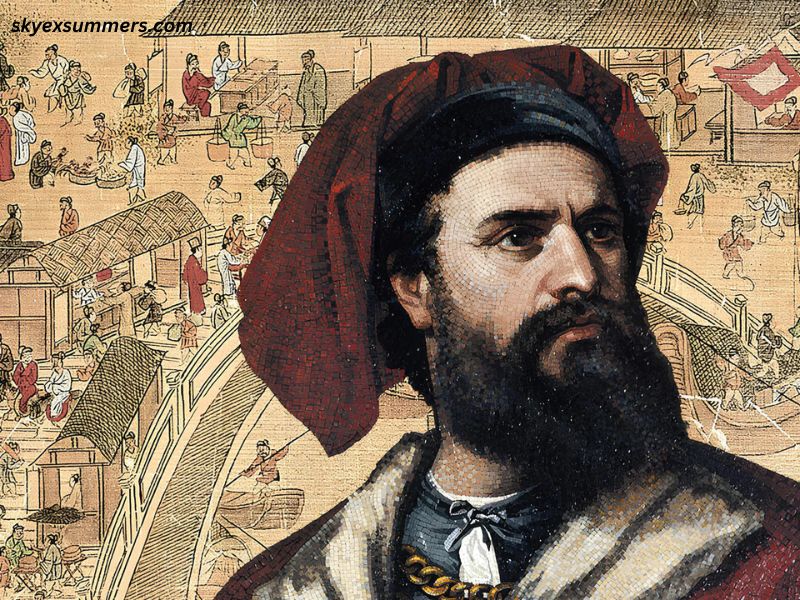Marco Polo, the Venetian merchant and adventurer, is often heralded as one of the most influential figures in the history of exploration. His detailed accounts of his travels to Asia, particularly in his book The Travels of Marco Polo, inspired a generation of explorers during the Age of Exploration. This period, spanning the 15th to 17th centuries, was marked by European voyages that expanded the known world and laid the foundation for global trade and cultural exchange. Marco Polo influenced the Age of Exploration by providing an unprecedented glimpse into the East, igniting curiosity, and shaping the ambitions of explorers like Christopher Columbus.
A Venetian Merchant’s Journey
Marco Polo was born in 1254 in Venice, a bustling city-state that thrived on trade. In 1271, Marco, along with his father Niccolò and uncle Maffeo, embarked on a journey to the court of Kublai Khan, the Mongol ruler of the Yuan Dynasty in China. The journey took them across the Silk Road, a network of trade routes connecting Europe and Asia. After traveling for over three years, the Polos arrived at Kublai Khan’s court, where Marco served as an envoy and official for 17 years.
The Polos returned to Venice in 1295, bringing with them treasures, tales, and experiences that were largely unknown to Europeans. Marco’s subsequent imprisonment during a Venetian-Genoese war led to the dictation of his travels to a fellow inmate, Rustichello da Pisa. The resulting book, The Travels of Marco Polo, became one of the most widely read and influential travelogues of the Middle Ages.
How Marco Polo Influenced the Age of Exploration
1. Providing Detailed Descriptions of Asia
Marco Polo influenced the Age of Exploration by providing Europeans with detailed descriptions of Asia’s wealth, culture, and geography. His accounts painted a vivid picture of the lands beyond Europe, including:
- China’s prosperity: Polo described the grandeur of Kublai Khan’s court, the advanced infrastructure of cities like Hangzhou, and the use of paper money—an innovation unknown in Europe at the time.
- Exotic goods: The book highlighted the abundance of spices, silk, and other luxury items, sparking European interest in direct trade routes to Asia.
- Geography and trade routes: Polo’s accounts of the Silk Road, major cities, and navigational routes became a reference for future explorers.
These descriptions were invaluable during the Age of Exploration, as they gave Europeans a tantalizing glimpse of the riches that awaited them in the East.
2. Igniting European Curiosity and Ambition
Marco Polo’s accounts inspired a spirit of curiosity and ambition among European explorers. His stories of wealth and opportunity in Asia encouraged adventurers to seek their fortunes abroad. Key examples include:
- Christopher Columbus: Columbus carried a copy of The Travels of Marco Polo with him during his voyages and believed he could find a westward route to Asia based on Polo’s descriptions.
- Ferdinand Magellan and Vasco da Gama: These explorers were driven by the same desire to reach Asia and access its riches, a vision fueled by Polo’s writings.
Marco Polo’s influence extended beyond individual explorers, shaping the policies and investments of monarchs and merchants eager to capitalize on global trade.
3. Bridging Cultures Through Knowledge Exchange
Marco Polo influenced the Age of Exploration by serving as a bridge between Eastern and Western cultures. His observations introduced Europeans to new technologies, ideas, and practices, such as:
- Innovations in navigation and commerce: Polo’s descriptions of advanced Asian shipbuilding techniques, compass use, and trade systems informed European maritime practices.
- Cultural understanding: Polo’s accounts fostered a broader awareness of diverse cultures and religions, contributing to the global outlook that characterized the Age of Exploration.
This exchange of knowledge helped Europe prepare for the challenges of long-distance voyages and establish connections with distant lands.
Marco Polo’s Legacy in the Age of Exploration
The influence of Marco Polo on the Age of Exploration can be seen in several key developments:
1. Expanding Geographic Knowledge
Before Polo’s travels, European maps were largely inaccurate and incomplete. His detailed descriptions of Asia, combined with other travelers’ accounts, improved the cartographic knowledge of the time. Notable impacts include:
- The Catalan Atlas (1375): One of the most important medieval maps, it incorporated information from Polo’s travels.
- Portolan charts: These maps, used by sailors during the Age of Exploration, often reflected details from Polo’s descriptions.
By providing a clearer understanding of Asia’s geography, Marco Polo laid the groundwork for navigational advancements.
2. Inspiring Exploration for Trade
Polo’s vivid portrayal of Asia’s wealth motivated European nations to explore new trade routes, especially after the fall of Constantinople in 1453, which disrupted overland access to the East. This led to:
- The search for sea routes: Explorers like Vasco da Gama sought maritime paths to India to bypass the Silk Road.
- Colonial expansion: European powers established trade networks and colonies in Asia, Africa, and the Americas to secure access to valuable resources.
Marco Polo’s vision of Asia as a land of opportunity fueled these efforts, shaping the trajectory of global trade.
3. Promoting Technological and Cultural Exchange
The Age of Exploration saw the transfer of knowledge and technology between continents, much of which had roots in Marco Polo’s observations. Examples include:
- Paper money and printing: Polo’s accounts of these innovations in China influenced European adoption of similar practices.
- Agricultural products: The exchange of crops and farming techniques during the Columbian Exchange was informed by earlier knowledge of Asian practices.
Marco Polo’s role as a cultural mediator underscored the importance of learning from other civilizations.
Criticism and Skepticism of Marco Polo’s Accounts
While Marco Polo’s influence on the Age of Exploration is undeniable, his accounts have faced criticism and skepticism over the centuries. Detractors argue that:
- Omissions raise doubts: Polo did not mention key Chinese practices such as tea drinking or the Great Wall, leading some historians to question the accuracy of his observations.
- Possible exaggerations: Certain details, such as the vast size of Kublai Khan’s empire, may have been embellished to captivate European readers.
Despite these criticisms, most historians agree that Polo’s accounts were groundbreaking for their time and contributed significantly to Europe’s understanding of the world.
Conclusion
Marco Polo influenced the Age of Exploration by providing a window into the East, igniting the imaginations of explorers, and fostering a spirit of curiosity and innovation. His detailed accounts of Asia’s wealth, culture, and geography served as a catalyst for European exploration, trade, and expansion.
The Age of Exploration, driven in part by Polo’s writings, transformed the world by connecting continents and cultures. While his stories may have included embellishments, their impact on the course of history is undeniable. Marco Polo’s legacy endures as a testament to the power of curiosity, knowledge, and the human desire to explore the unknown.



